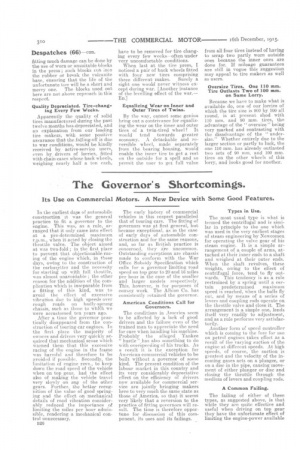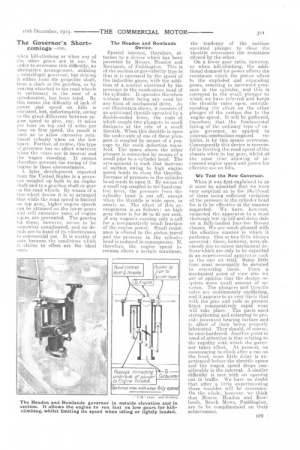The Governor s Shortcomings.
Page 6

Page 7

If you've noticed an error in this article please click here to report it so we can fix it.
Its Use on Commercial Motors. A New Device with Some Good Features.
In the earliest.day,v of automobile construction ' it was the general Practice to -fit a governor to the engine. This was, as a. rule, arranged that it only came into effect at a pre-determined maximum. r.p.m., when it acted by closing the throttle valve. The object aimed at was two-fold; in the first place to prevent that objectionablesracing of the engine which, in those days, owing to the construction of the carburetter and the necessity for starting up with full throale, was almost unavoidable ; the other reason for the addition of the complication which is inseparable from a fitting of this kind, was to avoid the effect of excessive vibration due to high speeds over rough roads on badly-sprung chassis, such as those to whf6h we were accustomed ten years ago.
After a. time the governor practically disappeared from the construction of touring-car engines. In the first: place the majority of owners and drivers very quickly acquired that mechanical sense which warned them that this excessive racing of the engine in the frame was harmful and therefore to be avoided if possible. Secondly, the limitation a engine revs., to keep down the road speed of the vehicle when on top gear, had the effect abso of making the vehicle travel very slowly on any of the other gears. Further, the better recognition of the value of good springing and the effect on mechanical details of road vibration considerably reduced reduced the importance of limiting the miles per hour admissible, rendering a mechanical con-. trol unnecessary.
B26
The early history of commercial vehicles in this respect paralleled that of touring cars. The fitting of governors was at first .general, but became exceptional, as in the case of early days of automobile construction and for the same reasons,and, so far as British practice is concerned, they are unc.omnrion. Outstanding exceptions are chassis made to conform with the War Office Subsidy Specification which calls for a governor limiting road speed on top gear to 20 and 16 miles per hour in the case of the smaller and larger models respectively. This, however, is for purposes of convoy work. The Albion Co. has consistently retained the governor.
American Conditions Call for Governors.
The conditions in America seem to be affected by a lack of good drivers and the failure even of the trained man to appreciate the need for care when handling his machine. Probably the alleged -Yankee " hustle "..has also something to do with overspeeding of his trucks. As a result it is the exception for American commercial vehicles to be built without a governor of some kind. The present condition of the labour market in this country and its very considerably depreciative effect on the efficiency of drivers now available for commercial service are jointly bringing makers here to very much the same state as those of America, so that it seems very likely that a reversion to the practice, of fitting governors will result. The time is therefore opportune for discussion of this component. its uses and its failings. Types in Use.
The most usual type is what is termed the centrifugal and is similar in principle to the one which was used in the very earliest stages of steam engineering by Newcomen for operating the valve gear of his steam engine. It is a simple arrangement of a couple of -arms, attached at their inner ends to zi shaft and weighed at their outer ends. When the shaft revolves, these weights, owing to the effect of centrifugal force, tend to fly outwards. This tendency is as .a rule restrained by a spring until a certain predetermined maximum speed is reached, when the balls fly out, and by means of a series of levers. and coupling rods operate on the throttle valve and close it. The arrangement is a simple one, lends itself very readily to adjustment, and as a rule performs very satisfactorily.
Another form of speed controller which is coming to the fore for use on petrol engines takes effect as a result of the varying suction of the engine at different speeds. At high speeds, of course, the suction is greatest and the velocity of the in-coming gases acts on a plunger, or on a disc in the pipe, causing movement of either plunger or disc and closing the throttle through the medium of levers and coupling rods.
A Common Failing.
The failing of either of these types, as suggested above, is that while they are quite effective and useful when driving on top gear they have the unfortunate effect of limiting the engine-power available when hill-climbing or when any of the other gears are in use. In order to overcome this difficulty, an alternative arrangement, utilizing a centrifugal governor, but driving it either from the propeller shaft, from a shaft in the gearbox, or by gearing attached to the road wheels is customary in the case of a speedometer, has been tried. By this means the difficulty of lack of power and speed on hills is obviated, but, unfortunately, owing to the great difference between engine speed to give, say, 12 miles per hour on. top and 12 miles per hour on first speed, the result is such as to allow excessive rotational velocity when on the low gears. Further, of course, this type ,if governor has no effect whatever when the "ears are in neutral and he wagon standing. It cannot therefore prevent the racing of the engine in these circumstances.
A later development reported from the 'United States is a goverkor coupled up both to an engine shaft and to a gearbox shaft or gear en the road wheels. By means of a free-wheel device it is so arranged that while the road speed is limited 0/1 top gear, higher engine speeds can be attained on the lower gears and still excessive rates of engine r.p.m. are prevented. The gearing for these, however, seems to be somewhat, complicated, and no details are to hand of its effectiveness in commercial use. It is worthy of note because the conditions which it claims to effect are the ideal ones.
The Headon and Rowlands Device.
Special interest, therefore, attaches to a device which has been patented by Messrs. Headon and Rowlands, of Paddington. This is of the suction or.gas-velocity type in that it is operated by the .speed of the induction gases, with the addition. of a control exercised by the pressure in the combustion, head of the cylinder. It operates therefore without there being any .needfor any form of mechanical drive. As our illustration shows, it consists cf an additional throttle operated by a double-ended lever, the ends of which couple two plungers in small dashpots at the side of a small throttle. When this throttle is open. the under-side of one of these plungers is coupled by means of a passage to the main induction manifold. The space above the other plunger is connected by means of a small pipe to a cylinder head. The arrangement is such that increase of. suction owing to high engine speed tends to close the throttle. Increase of pressure in the cylinder head tends to open it. By means of a small tap coupled to the hand control lever, the pressure from the cylinder head is cut off, except when the throttle is wide open, or nearly so. The effect of this arrangement is as follows : on high gear there is for 90 to 95 per cent. of any wagon's running only a call for a comparatively small fraction of the engine power. Small resistance is offered to the piston travel and the pressure in the cylinder head is reduced in consequence. If, therefore, the engine speed increases above a certain maximum,
the tendency of the suctionoperated plunger to close the throttle overcomes the resistance offered by the other.
On a lower gear ratio, however, or when hill-climbing, the additional demand or power affects the resistance which the piston oilers to the exploded and expanding gases, resulting in increased pressure in the cylinder, and this is conveyed to the small plunger to which we have referred and keeps the throttle valve open, notwithstanding the effect on the other plunger of the suction due to the engine speed.. It will be gathered, therefore, that the fundatlICIntal failing of the ordinary -type Lf gine governor, as applied to internal-combustion-engined vehicles, is by this means overcome. Consequently this device is success
ftil limiting the road speed of the chassis when in top gear, whilst at the same time allowing of increased engine speed and power for effective use on hills.
We Test the New Governor.
When it was first explained to us it must be admitted that we were very sceptical as to the likelihood of there being sufficient variation of the pressure in the cylinder head for it to be effective in the manner suggested. We have, however, subjected the apparatus to. a most thorough test up hill and down dale on a fully-loaded four-ton Bomar chassis. We are much pleased with the effective manner in which it performs. One or two little hitches occurred ; these, hOwever, were obviously due to minor mechanical defects'which are only to be expected in an experimental apparatus such as the one on trial. Seine little time must necessarily be devoted to correcting these. From a mechanical point of view also we are of opinion that the design requires some small amount of revision. The plungers and throttle valve are continuously oscillating, audit appears to us very likely that with the .pins and rods at present fitted. comparatively rapid wear will take place. The parts need strengthening and enlarging to provide, increased bearing surface and te allow of their being properly lubricated. They should, of course, be .case-hardened. Another piiint in need of attention is that relating to the rapidity with which the 'governor takes effect. At present, on commencing to climb after a. run on -the level, some little delay is experienced before the throttle opens and the wagon speed drops considerably in the interval. A similar difficulty is met with on opening out in traffic. We have no doubt that after a little experimenting these troubles will be overcome. On the whole, however, we think that Messrs. Headon and Rowlands. Brook Mews, Paddington,. are to be complimented on their achievement.




















